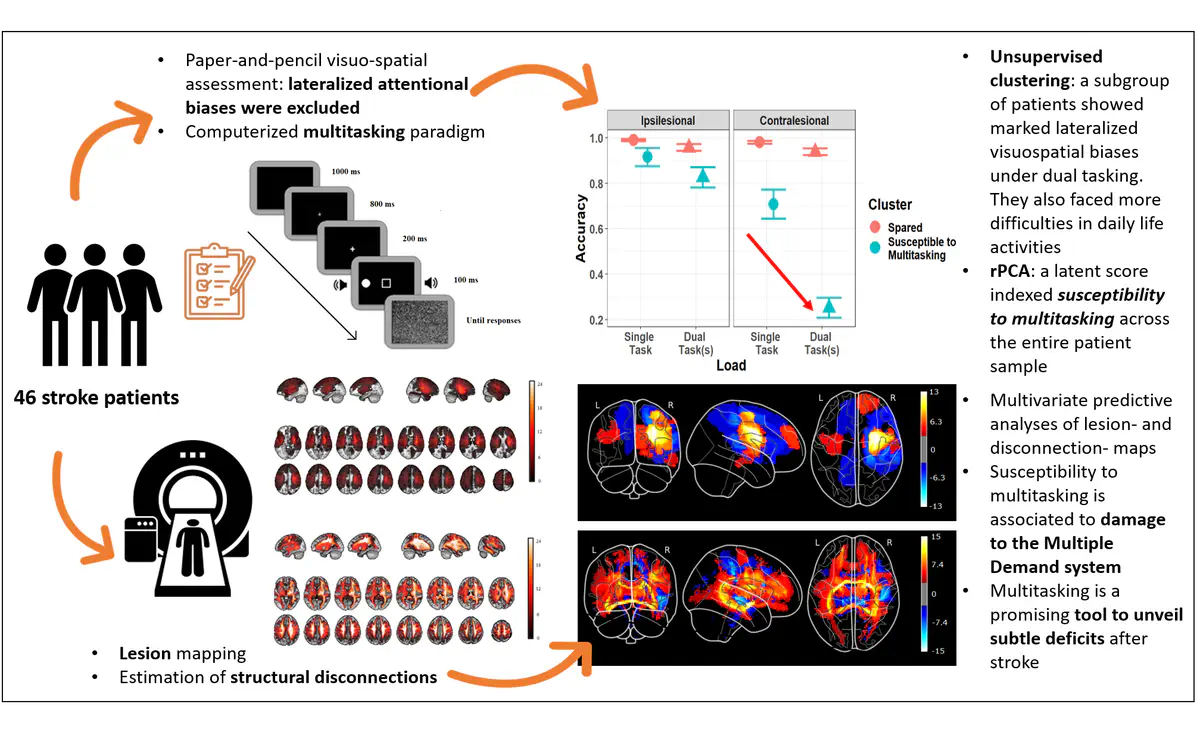New preprint!
Susceptibility to multitasking in chronic stroke is associated to damage of the multiple demand system and leads to lateralized visuospatial deficits
 Graphical abstract, Blini et al., link
Graphical abstract, Blini et al., link
Hello there!
A new preprint is out! link
The background of this study is the observation that, due to advances in stroke management, the line separating relatively spared patients and patients with some degree of impairment is moving, all while becoming more blurred and uncertain. This is arguably paramount to better frame diagnosis and rehabilitation strategies. Thus, this article sets out to explore what marks the passage, after stroke, to clinically manifest symptoms, by using lateralized attentional disorders as an exemplary case.
We have tested a cohort of 46 chronic, first-ever stroke patients, selected for the absence, in standardized neuropsychological tests, of lateralized attentional disorders (i.e., spatial neglect). Patients were administered with a computerized task that exploited multitasking (i.e., attentional load) as a tool to disclose hidden deficits, if any, by stressing a domain-general, Multiple Demand system and thus the inherent information processing limits of the brain. We then used an unsupervised clustering algorithm to classify the multivariate pattern of their performance in one of two groups: confirmed-spared, or highly susceptible to multitasking. We show that the latter group indeed presents with stark lateralized deficits of attention, though limited to conditions of multitasking. The distinction unveiled by these data is not a mere theoretical detail: patients in the highly susceptible group presented higher scores, indicative of more difficulties, in the assessment of activities of daily living.
We also used rotated Principal Component Analysis to extract a latent factor that provides an index of susceptibility to multitasking across the entire sample. This latent factor was then used to relate multitasking performance to brain lesions and structural disconnections using a predictive multivariate approach. Notably, lesion volume was not a determinant of the susceptibility to multitasking, whereas lesions to frontal white matter extending into areas associated with the multiple demands network (i.e., frontal operculum and anterior insula) were found to predict the degree by which lateralized deficits arose during multitasking. The predictive structural disconnectome involved MD-related connectivity (i.e., anterior thalamic radiation) previous associated to multitasking in healthy subjects, as well as fronto-parietal connections known to be implicated in neglect (SLF II), thereby suggesting that white matter disconnections underlie the impaired interaction between domain-general mechanisms (MD) and domain-specific processing (i.e., visuo-spatial processing in PPC).
I’ve started working on this (and related) projects almost 10 years ago, when I first reached Padova for my Ph.D. The work has been massive and I really want to thank profusely all the coauthors for what is, I believe, a very complete and extensive work on this topic, and the one that finally allows us to clearly stress the importance of the take-home message.
The mismatch between the amount of brain damage and the observed behavioral deficits has always been puzzling, and many constructs have been proposed to try to fill the gap (e.g., cognitive/brain reserve). With this paper, we firmly put forward the idea that the framework of multitasking provides the opportunity to study – with greater experimental control and in a finely-grained, parametric fashion – the instances in which compensation is no longer possible.
Successful compensation for a deficit is a desirable feature, as it may indicate that sufficient cognitive resources can be recruited when needed to overcome everyday life challenges and difficulties. But this condition may be fragile, as for a substantial share of patients these resources may be limited and rigidly capped. Hence, assessing susceptibility to attentional load allows one to objectively quantify the extent by which these patients would struggle in more taxing conditions, thereby enhancing our understanding of their needs. We believe that this may by itself represent a novel, fresh take on a matter of long-lasting debate.
The full article is available on biorxiv: https://www.biorxiv.org/content/10.1101/2023.10.11.561866v1